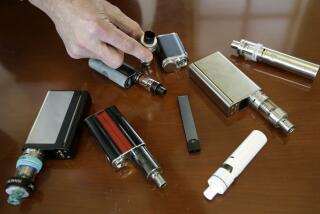This room was off-limits to smokers, but its air contained surprising amounts of ‘thirdhand smoke’

Study leader Peter DeCarlo, an air quality researcher at Drexel University, explains how thirdhand smoke got into a classroom that’s off-limits to smokers. (Credit: Peter DeCarlo)
Pop quiz: If you sampled the air in an empty college classroom where smoking is not permitted, what is the last thing you’d expect to find?
If you guessed “cigarette smoke,” you’re in good company. Peter DeCarlo, an air quality researcher at Drexel University in Philadelphia, would have agreed with you.
But when he examined the air from the unoccupied room, he discovered that 29% of the tiny particles suspended within it could be traced to the residue of cigarette smoke.
“This was a surprising finding, and not something that we were even looking for when we started making the measurements,” DeCarlo recounted in a video describing his research, which was published Wednesday in the journal Science Advances. “It made us dig deeper and try to understand how a nonsmoking classroom could have so much influence from tobacco smoke.”
There was nothing special about the classroom. It had about 25 student desks, painted brick walls and a tile floor. It was also conveniently located across the hall from a laboratory that contained an aerosol mass spectrometer, which identifies and measures the tiny components of air.
The classroom was hooked up to a heating, ventilation and air-conditioning system that drew in air from the outside. DeCarlo and his colleagues had set out to compare the air inside the room to the air outdoors.
They found that most of the aerosols they detected in the classroom originated from the outside. In most cases, the concentrations in the room were lower than they were outdoors, thanks to the HVAC’s filtration system.
But there was one exception. Among the four types of organic aerosols identified by the mass spectrometer, one was found mainly in the classroom. And that aerosol contained the residue of cigarette smoke.
The researchers called it “thirdhand smoke.”
Unlike secondhand smoke, which lasts for only a short time after a cigarette is consumed, thirdhand smoke can linger in the environment by sticking to clothing, upholstery, walls and other surfaces. When they get a chance to react with certain types of chemicals — including ammonia, which humans emit — they can become airborne again, ultimately winding up in aerosols that we breathe.
Studies in mice have shown that thirdhand smoke can affect growth and damage the immune system, but the full effects on human health are not yet clear.
How did this thirdhand smoke get into this classroom? The entire building was subject to nonsmoking rules, so indoor smoking was deemed “highly unlikely,” according to the study. In addition, the experiment was conducted in August, when the classroom wasn’t in use.
DeCarlo and his team noted that the room was about 65 feet from an outdoor balcony, where “illicit smoking activity” was known to occur. They added that “several smokers” shared an office in the same HVAC zone as the classroom. These two sources were deemed the most likely culprits.
To see what was happening to these thirdhand smoke particles in the classroom, the researchers took a Pyrex container and blew cigarette smoke into it. A day later, they pulled outdoor air through the container, allowing it to react with the smoke residue left behind.
They found that compared to the pure outdoor air, the air that went through the Pyrex vessel contained much more thirdhand smoke.
If thirdhand smoke was present in this one classroom they happened to study, it’s probably in lots of other places too, DeCarlo and his colleagues wrote.
For starters, other rooms that share the same ventilation system would be in jeopardy. “A room occupied by a smoker can effectively expose the other occupants served by the same HVAC system to [thirdhand smoke], even if they do not share space directly,” they wrote.
And the same thing could be happening in apartment buildings, offices, hotels, rental cars, airplanes and other shared spaces, they added.
“It’s a new exposure route that has not been previously identified,” DeCarlo said.
Follow me on Twitter @LATkarenkaplan and “like” Los Angeles Times Science & Health on Facebook.
MORE IN SCIENCE
It’s not just you, we’re all living in the United States of Anxiety
Global travel may be good for the soul, but its huge carbon footprint means it’s bad for the planet
In veterans, even a mild case of traumatic brain injury is linked to an increased risk of dementia







